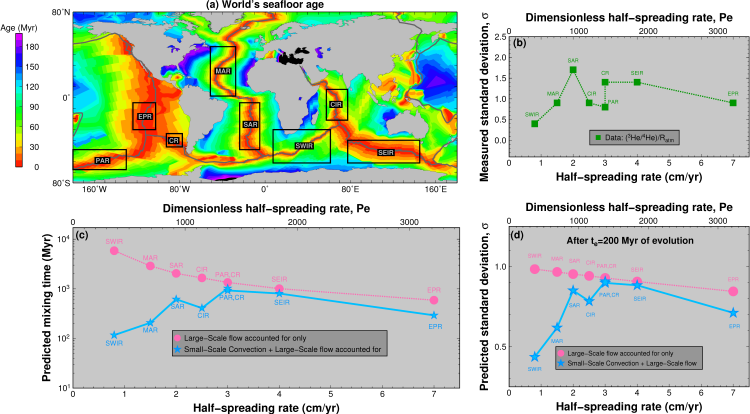
Henri Samuel & Scott D. King
Nature Geoscience 7, 602–605 (2014)
http://www.nature.com/ngeo/journal/v7/n8/full/ngeo2208.html
See also New and Views:
http://www.nature.com/ngeo/journal/v7/n8/full/ngeo2216.html
Oceanic lavas are thought to be derived from different sources within the Earth’s mantle, each with distinct compositions. The geochemical variability from a suite of samples from the same region is interpreted as an indication of how well these different sources are mixed, and large-scale plate motions are generally accepted as the primary mixing mechanism. While lavas erupted at ocean island hotspots such as Hawaii have more diverse geochemical signatures than lavas erupted at mid-ocean spreading centers, the geochemical signatures from different mid-ocean rigdes can still vary significantly. For fast-spreading ridges, geochemical variability decreases with increasing spreading rate, consistent with plate-scale mixing. However slow-spreading centers, such as the Southwest Indian Ridge, are also geochemically homogeneous, which is inconsistent with plate-scale mixing (Fig a-b). We used numerical simulations of mantle flow, varying plate length and spreading rates to study mantle mixing. Our calculations reveal that small-scale convection contributes significantly to mantle mixing at slow spreading rates, while faster plate velocities and smaller plates inhibit small-scale convection (Fig. c-d). Our results show that slow-spreading ridge lavas will be well mixed by small-scale convection while fast-spreading ridge lavas will be well mixed by plate-scale flow. This resolves the paradox of geochemically homogeneous lavas at slow-spreading ridges (Fig. b). In addition, the interplay between small-scale convection and plate-driven flow provides a way to explain characteristic differences in isotopic variabilities between MORB and OIB without requiring the existence of isolated geochemical reservoirs in the Earth’s mantle.

Helium variability and predicted mixing times along mid-ocean ridges.
a, Seafloor age and eight selected regions (labelled rectangles) considered in b–d.
b, Standard deviation of R=3He/4He measured along spreading centres, normalized to the atmospheric ratio value, Ratm,
versus ridge’s half-spreading rate.
c, d, Predicted mixing times (c) and standard deviations (d) of chemical heterogeneities versus ridge’s half-spreading rate,
assuming that mixing is entirely due to surface-plate motion (pink circles), or making the more reasonable assumption
that mixing results from the combination of small-scale convection and surface-plate motion (blue stars).
Tel: +49-(0) 921 55 3700 / 3766, Fax: +49-(0) 921 55 3769, E-mail: bayerisches.geoinstitut(at)uni-bayreuth.de